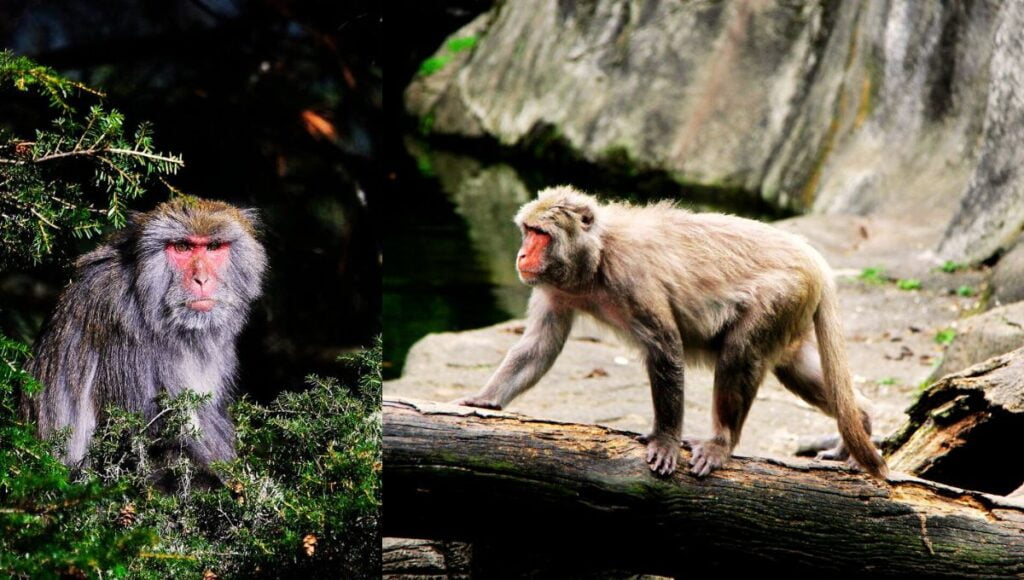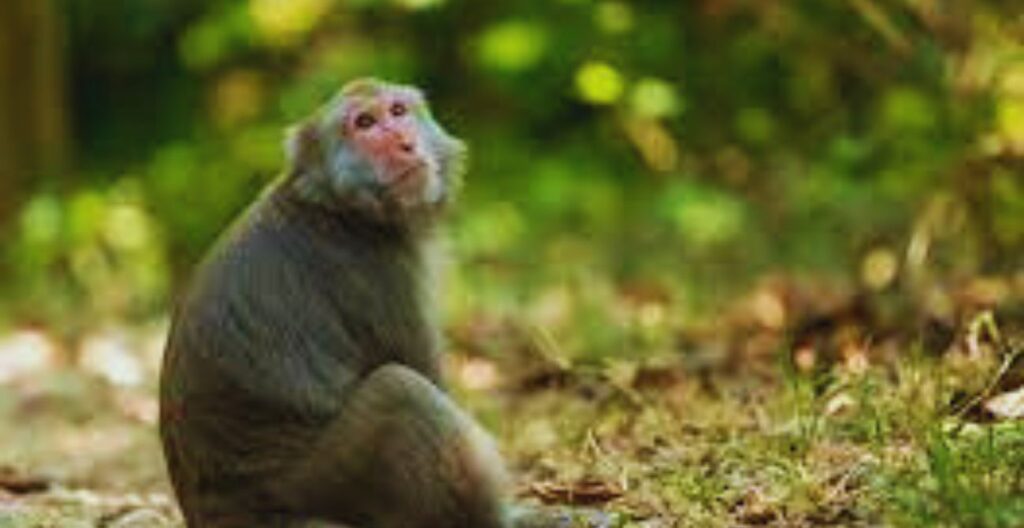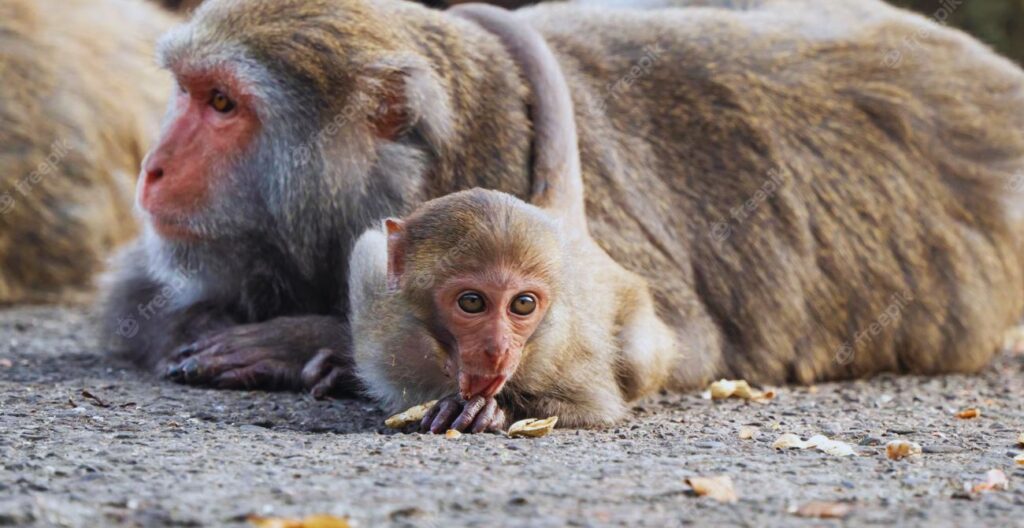Formosan Rock Macaque, also known as Taiwanese macaque, is the only native primate besides humans to live in Taiwan. The macaque is an iconic symbol to the country as the species is endemic to Taiwan. In this article, we will delve into the world of the Formosan rock macaque and find out the distinctive characteristics and behaviour of the species.

Table of Contents
Formosan Rock Macaque- In a Glimpse:
| Common Name: | Formosan Rock Macaque |
| Scientific Name: | Macaca cyclopis |
| Other Name: | Taiwanese Macaque |
| Group Name: | Troop |
| Adult length: | 50-60 cm |
| Adult Weight: | 5-12 kg |
| Colour: | Grey or Brown |
| Lifespan: | 30 Years |
| Sexual Dimorphism? | Yes |
| Distribution: | Taiwan |
| Habitat: | Broadleaf evergreen forest, broadleaf-coniferous, coniferous, and bamboo forests |
| Characteristics: | Diurnal, territorial as well as arboreal. |
| Diets: | fruits, leaves, seeds, insects etc |
| Predators: | Cloud Leopard |
| IUCN Status: | Least Concern |
6 Fascinating Facts About Formosan Rock Macaque:
Scientific Classification:
| Kingdom | Animalia |
| Phylum | Chordata |
| Subphylum | Vertebrata |
| Class | Mammalia |
| Order | Primate |
| Suborder | Haplorhini |
| Infraorder | Simiiformes |
| Family | Cercopithecidae |
| Genus | Macaca |
| Species | Macaca cyclopis |
Physical Description:

The macaques are small in size and very agile in nature. The length of the rock macaques is 50-60 cm and the males are a little larger than the females. Their weight varies between 5 kg and 12 kg, the males are heavier. The colour of Taiwanese macaques is either grey or brown. Unlike other macaque species, their tails are smaller in size compared to their body.
The length of their tail usually measures between 26 and 45 cm. Their pouch-like cheeks help them hoard the food and consume them later. The macaques have a light red colour face and their ears are covered with furs. The colour of their fur changes with the season. The fur appears dark grey in winter and light-coloured in summer.
Lifespan:
Like other macaque cousins, the Formosan rock macaque lives up to 30 years in the wild.
Distribution and Habitats:
Formosan rock macaques are endemic to Taiwan. However, some locals introduced the species in Japan in the last century, known as snow macaque, a hybrid of Taiwanese macaque and Japanese macaques.
Broadleaf evergreen forests, broadleaf-coniferous, coniferous, and bamboo forests are the preferred destination of the macaques.
Behaviour:

The macaques are diurnal, territorial as well as arboreal. They can run with their fours on the grounds and trees. They are very agile and masters at jumping and climbing trees. The monkeys are not shy to deal with humans. They often raid crops and enters human residence for food resulting in confrontation with a human. In tourist places, they also interact with tourists and hikers and consume the food offered by tourists.
Daily Life and Group Activity:
The monkeys live in a multi-male and multi-female group which can extend up to 45-50 members and even more. Nowadays, many macaques live in a uni-male system in which the group consists of 9-10 members.
The hierarchy in the group is strictly based on the social hierarchy. The males are usually dominant over females. The hierarchy among females is based on age and among males it is based on strength. Food and mating are the main central points of the hierarchy. Adult males sometimes change the native group to secure a higher position in another group.
Communication:
Solitary males are accounted for only 5% of the population. During mating season, they interact with the groups to find a female partner through visual signals and sound. They will “scream” when a non-group member comes near them. The group member replies with “kyaw-kyaw”.
Diets:
The Formosan rock macaque spends 5/8th of the day foraging for food. Their diets consist of fruits, leaves, stems, buds, insects and birds’ eggs.
Reproduction:
| Mating season: | October- January |
| Breeding Interval: | 1 Year |
| Sexual Orientation: | Polygamous |
| Gestation Period: | 165 days |
| Litter Size: | 1 |
| Weaning age: | 2-3 Months |
| Age of Independence: | 1 Year |

The mating season usually starts in October and continues till January. Usually, one female gives birth to one infant at a time. Like other macaque cousins, Formosan rock macaques are polygamous and a hierarchy is present while mating. A dominant male, can monopolize any female in estrus and ensure she only carries his offspring. However, other females generally mate with up to 5 partners a day.
During estrus, the perineum of the female swells at the base of the tail and their thighs also swells. The gestation period is about five and half months or 165 days usually. The female gives birth in spring or summer and one infant at a time. The females are solely responsible for nursing and grooming the young. The infants are carried in the mother’s arms for 2-3 months and they become independent at the age of 1 year. Alloparenting is also seen in this species for the first month.
Significance of the Taiwanese Macaque:
Ecological Impact:
Like other macaques, the Formosan rock macaques spread the seeds of fruits on the ground and it helps to spread the forest.
Cultural Significance:
The Taiwanese monkey is deeply connected with Taiwan’s mythology. The species is seen as the spiritual messenger who bridges the world. In essence, its image of crafts indicates the rich cultural, spiritual and traditional spirits of Taiwan.
Threats:

The species faces a lot of threats in the wild which include:
- Habitat loss
- Fragmentation of the habitat
- Increasing human settlements force the species to move northwards from their natural habitat.
- Confrontation with humans while raiding crops and stealing food from houses.
- Hunting and trapping. Etc
Predators:
Rock macaques are very agile and elusive species and they don’t have many natural predators. The only known predator of the macaques is the cloud leopard.
Conservation Status:
The population of the Taiwanese macaque are stable and even increasing over time. It is listed as “Least Concern” in the IUCN Red List of Threatened Species.
Frequently Asked Questions (FAQ):
What is the difference between a monkey and a macaque?
There is no such difference between Macaque and Monkey. Macaque is a sub-type of monkey which is primarily found in the Eastern Hemisphere.
Where do Formosan rock macaques live?
Formosan Rock Macaque or Taiwanese Macaque is endemic to Taiwan. They prefer broadleaf evergreen forests, broadleaf-coniferous, coniferous, and bamboo forests as habitats.
Is it a macaque monkey or an ape?
Macaque is a sub-type of monkey and it is closely related to monkey. Apes are old-world simians native to Southeast Asia and Africa. Apes belong to superfamily of Hominoidea and macaque is part of Cercopithecidae.Apes generally lack external tails whereas macaque has tails. Hence, a macaque is more of a monkey than an ape.
Does the macaque monkey have emotions?
Yes, the macaque monkey has emotions. The life of macaque is full of ups and downs like a human. They live in groups and they have strong sense of friendship and rivalry. They take care of each other, show fear, happiness and sexual desires like human.
Also Read: Bonnet Macaque: 6 Fascinating Facts About the Endangered
Also Read: Colombian Red Howlers: 10 Fun Facts About the Red Howlers